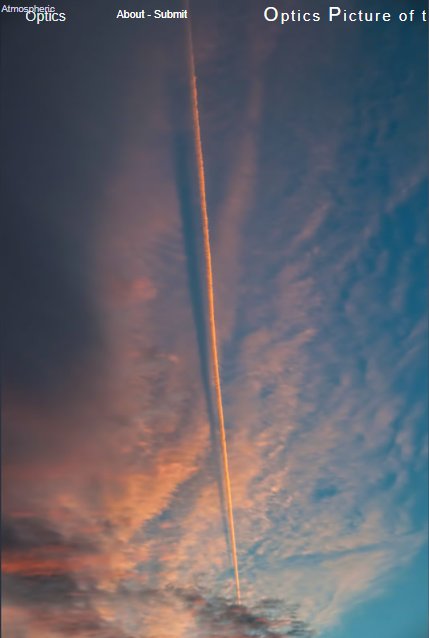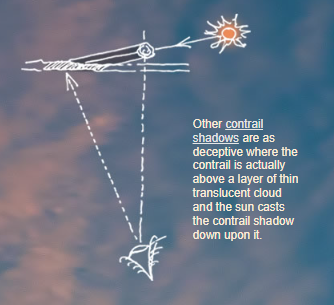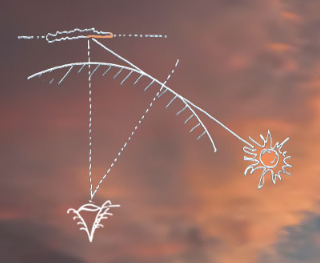Sunset Contrail Shadow - OPOD
Sunset Contrail Shadow - A Phenomenon Explained
Sunset is a magical time of day when the sky transforms into a stunning display of colors. It is during this time that we may witness a peculiar atmospheric optics phenomenon known as the sunset contrail shadow. Contrails, the condensation trails left behind by aircraft, can cast dark shadows onto high clouds, creating a visually captivating sight. In this article, we will delve into the science behind this phenomenon and explore why the contrail shadow appears to be lower than the clouds and how the sun seemingly casts the shadow upwards.
Contrail shadows can sometimes be deceptive, as they may give the illusion that the contrail is positioned below a layer of thin, translucent cloud. In reality, the contrail is actually above the cloud layer, and it is the sun that casts the contrail shadow down upon it. This optical illusion can be attributed to the angle at which the sunlight interacts with the clouds and contrail.
Under normal circumstances, the sun does not shine and cast shadows upwards due to the obstruction posed by the Earth's surface. However, there are slight exceptions shortly after sunset when the sun has already set at ground level but continues to illuminate high clouds for a brief period. During this time, if a cloud happens to be directly overhead, the sun's rays can slant upwards (as observed locally) and illuminate the underside of the cloud. These rays come from the west and graze the Earth's surface, creating a unique lighting effect.
To understand the magnitude of this effect, let's consider some simple geometry. High cirrus clouds, located at an altitude of approximately 30,000 feet, could theoretically be illuminated by rays shining upwards at an angle of just 3 degrees. However, it is important to note that this calculation does not account for atmospheric refraction, which would further reduce the angle to approximately 2 degrees. Despite its small scale, this phenomenon can still produce noticeable visual effects in the sky.
At sunset, we often observe clouds being underlit, creating a mesmerizing display. This occurs due to a combination of factors. First, irregularities within the clouds can catch the near-horizontal rays of the setting sun, enhancing their visibility. Additionally, skylight in the western sky contributes to the illumination of the clouds from below. Lastly, the translucent nature of some clouds allows light to pass through, further accentuating their appearance during sunset.
The images captured by Janet Furlong in Culpeper, Virginia, beautifully showcase the interplay between contrail shadows and high clouds during sunset. As a cold front was moving in, the advancing cloud layer with its lower side irregularities became sunlit, creating a dynamic and picturesque scene. These captivating moments in nature remind us of the awe-inspiring beauty that can be found in atmospheric optics.
In conclusion, the sunset contrail shadow is an intriguing phenomenon that occurs when contrails cast shadows onto high clouds during sunset. Despite appearing as though the contrail is lower than the clouds and the sun is casting the shadow upwards, this optical illusion is a result of the angle at which sunlight interacts with the clouds. By understanding the science behind this phenomenon, we can appreciate the intricate beauty of our atmosphere and the captivating displays it presents during sunset.

Sunset Contrail Shadow
Janet Furlong caught this scene close to sunset at Culpeper, Virginia as a cold front was moving in.
The long sunlit contrail casts a dark shadow onto high cloud. The contrail 'looks' as though it is lower than the clouds and the sun is somehow casting the shadow upwards. Can that ever be?
Images ©Janet Furlong, shown with permission

Other contrail shadows are as deceptive where the contrail is actually above a layer of thin translucent cloud and the sun casts the contrail shadow down upon it.
Can the sun shine and cast shadows upwards?
Not usually, the earth would get in the way.
But.. ..there are slight exceptions shortly after sunset. The sun has then set at ground level but for a while it continues to illuminate high clouds. If a cloud were overhead as shown (below), sun rays could slant upwards (as judged locally) to illuminate its underside. The rays come from the west and have grazed the earth's surface there.
Simple geometry show that the effect is tiny. High cirrus at 30,000ft could, in principle, be lit by rays shining upwards at an angle of a mere 3°. That calculation ignores atmospheric refraction which would reduce the angle further to ~2°.
We see clouds underlit at sunset (see the bottom below) mostly because irregularities catch the near horizontal sun rays, because skylight in the west lights them and because they are sometimes translucent.


The advancing cold front clouds with lower side irregularities sunlit.
Note: this article has been automatically converted from the old site and may not appear as intended. You can find the original article here.
Reference Atmospheric Optics
If you use any of the definitions, information, or data presented on Atmospheric Optics, please copy the link or reference below to properly credit us as the reference source. Thank you!
-
<a href="https://atoptics.co.uk/blog/sunset-contrail-shadow-opod/">Sunset Contrail Shadow - OPOD</a>
-
"Sunset Contrail Shadow - OPOD". Atmospheric Optics. Accessed on November 26, 2024. https://atoptics.co.uk/blog/sunset-contrail-shadow-opod/.
-
"Sunset Contrail Shadow - OPOD". Atmospheric Optics, https://atoptics.co.uk/blog/sunset-contrail-shadow-opod/. Accessed 26 November, 2024
-
Sunset Contrail Shadow - OPOD. Atmospheric Optics. Retrieved from https://atoptics.co.uk/blog/sunset-contrail-shadow-opod/.